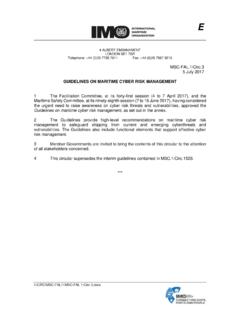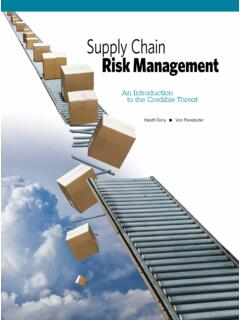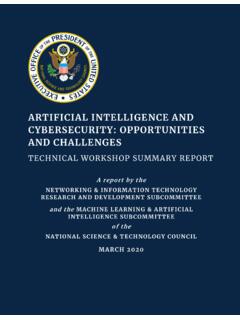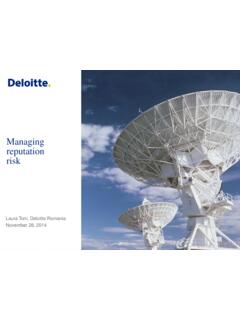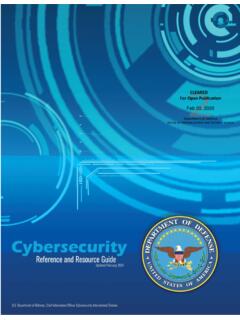Transcription of Compliance risk assessments - Deloitte
1 Compliance risk assessmentsThe third ingredient in a world-class ethics and Compliance program2 You can t mitigate a risk if you don t know it s thereAs global regulations proliferate, and as stakeholder expectations increase, organizations are exposed to a greater degree of Compliance risk than ever before. Compliance risk is the threat posed to an organization s financial, organizational, or reputational standing resulting from violations of laws, regulations, codes of conduct, or organizational standards of practice. To understand their risk exposure, many organizations may need to improve their risk assessment process to fully incorporate Compliance risk case for conducting robust Compliance risk assessments is deeply rooted in the Federal Sentencing Guidelines for Organizations, which establishes the potential for credit or reduced fines and penalties should an organization be found guilty of a Compliance failure.
2 In today s environment of global regulatory convergence, ever-increasing complexity, and the expansion of businesses into new or adjacent industries, the need for a broader view of Compliance risk has never been greater. Nevertheless, according to a survey conducted jointly by Deloitte and Compliance Week,1 40 percent of companies do not perform an annual Compliance risk ethics and Compliance officers will likely agree that new ethics, Compliance , and reputational risks appear each day. At the same time, the recent global recession forced many organizational functions to closely examine their budgets and resources.
3 Together, these factors have created a tension between growing regulatory obligations and the pressure to do more with less. To help resolve this situation and continue to add value to their organizations, ethics and Compliance professionals need to be sure they understand the full spectrum of Compliance risks lurking in each part of the organization. They then need to assess which risks have the greatest potential for legal, financial, operational, or reputational damage and allocate limited resources to mitigate those risks . 1 In focus: 2014 Compliance Trends Survey. is a Compliance risk assessment different from other risk assessments ?
4 Organizations conduct assessments to identify different types of organizational risk. For example, they may conduct enterprise risk assessments to identify the strategic, operational, financial, and Compliance risks to which the organization is exposed. In most cases, the enterprise risk assessment process is focused on the identification of bet the company risks those that could impact the organization s ability to achieve its strategic objectives. Most organizations also conduct internal audit risk assessments to aid in the development of the internal audit plan. A traditional internal audit risk assessment is likely to consider financial statement risks and other operational and Compliance risks .
5 While both of these kinds of risk assessments are typically intended to identify significant Compliance -related risks , neither is designed to specifically identify legal or regulatory Compliance risks (see illustrative table). Therefore, while Compliance risk assessments should certainly be linked with the enterprise or internal audit risk processes, they generally require a more focused approach. That is not to say that they cannot be completed concurrently, or that they ought to be siloed efforts most organizations may be able to combine the activities that support various risk assessments , perhaps following an initial Compliance risk identification and assessment used in this document, Deloitte means Deloitte & Touche LLP, a subsidiary of Deloitte LLP.
6 Please see for a detailed description of the legal structure of Deloitte LLP and its subsidiaries. Certain services may not be available to attest clients under the rules and regulations of public risk assessments The third ingredient in a world-class ethics and Compliance program 3 The interrelationship among enterprise risk management (ERM), internal audit, and Compliance risk assessmentsERMI nternal auditComplianceObjectiveIdentify, prioritize, and assign accountability for managing strategic, operational, financial, and reputational risksDetermine and prioritize risks to aid in developing the internal audit plan, helping to provide the board and the executive team with assurances related to risk management efforts and other Compliance activitiesIdentify, prioritize, and assign accountability for managing existing or potential threats related to legal or policy noncompliance or ethical misconduct that could lead to fines or penalties.
7 Reputational damage, or the inability to operate in key marketsScopeAny risk significantly impacting the organization s ability to achieve its strategic objectivesFinancial statement and internal control risks , as well as some operational and Compliance risks that are likely to materially impact the performance of the enterprise or financial statementsLaws and regulations with which the organization is required to comply in all jurisdictions where it conducts business, as well as critical organizational policies whether or not those policies are based on legal requirementsTypical ownerChief Risk Officer/ Chief Financial OfficerChief Audit ExecutiveChief Compliance OfficerUnderstanding your top Compliance risksThe Compliance risk assessment will help the organization understand the full range of its risk exposure, including the likelihood that a risk event may occur, the reasons it may occur, and the potential severity of its impact.
8 An effectively designed Compliance risk assessment also helps organizations prioritize risks , map these risks to the applicable risk owners, and effectively allocate resources to risk mitigation. Building a framework and methodologyBecause the array of potential Compliance risks facing an organization is typically very complex, any robust assessment should employ both a framework and methodology. The framework lays out the organization s Compliance risk landscape and organizes it into risk domains, while the methodology contemplates both objective and subjective ways to assess those risks . The framework needs to be comprehensive, dynamic, and customizable, allowing the organization to identify and assess the categories of Compliance risk to which it may be exposed (see Figure 1).
9 Some Compliance risks are specific to an industry or organization for example, worker safety regulations for manufacturers or rules governing the behavior of sales representatives in the pharmaceutical industry. Other Compliance risks transcend industries or geographies, such as conflicts of interest, harassment, privacy, and document effective framework may also outline and organize the elements of an effective risk mitigation strategy that can be applied to each Compliance risk domain. Fraud andCorruption FinancialComplianceDirect and Indirect TaxAnti-MoneyLaunderingAnti-trust &ConsumerProtectionEnvironment,Health,an d Safety External/RegulatoryReportingLabor &Employment LegalLicense &PermitsCybersecurity& PrivacyVendorRelationshipManagementCusto merRelationshipManagementSupply Chain Trade/Import/ExportOperations Third Party Compliance Training and Communications Case Management and Investigations Continuous Improvement Governance and Leadership Employee Reporting Risk assessments and Due Diligence Standards, Policies.
10 And Procedures Testing and Monitoring Culture of Ethics and Compliance Figure 1: Enterprise ethics and Compliance program and risk exposure framework An illustrative example ( Deloitte Development LLC)4 Applying the methodology and conducting the risk assessmentUsing an objective methodology to evaluate the likelihood and potential impact of each risk will help the organization understand its inherent risk exposure. Inherent risk is the risk that exists in the absence of any controls or mitigation strategies. At the outset, gaining a preliminary understanding of inherent risk helps the organization develop an early view on its strategy for risk mitigation.











